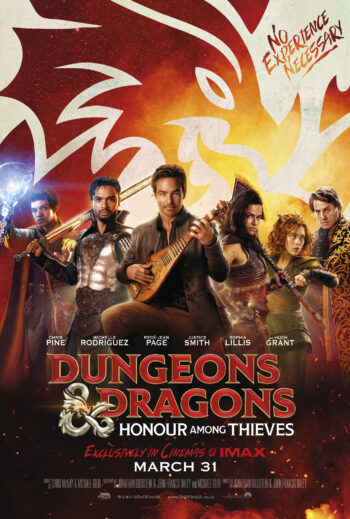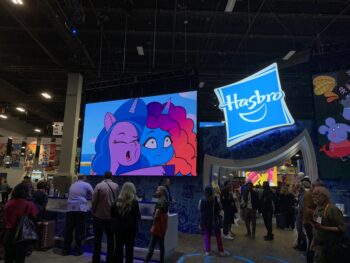Claire Gilchrist Explains How Hasbro’s ‘Church of Focus’ is Designed to Create Billion Dollar Brands
By Gary Symons
TLL Editor in Chief
Of all the interviews I conducted at Licensing Expo this year, among the most interesting was with Hasbro VP Claire Gilchrist.
We’ve written before about Hasbro’s plans to streamline its operations into three primary silos—Entertainment, Consumer Products, and Wizards of the Coast. That latter covers the company’s phenomenally successful role-playing games including Dungeons & Dragons and Magic: The Gathering.
But less obvious has been Hasbro’s equally ruthless streamlining of its operations to essentially focus on eight core brands, those being: Transformers, My Little Pony, Peppa Pig, Dungeons & Dragons, NERF, Magic: The Gathering, Play-Doh, and Hasbro Gaming, anchored by Monopoly.

“We are really going through a transformation,” Gilchrist told me, as she was flanked by gigantic Peppa Pigs and Transformer characters at the Hasbro booth. “Since the arrival of Chris Cocks as our new CEO about 14 months ago, we have undertaken a very significant, deep dive into which brands we should be focused on.
“So we’re really driving what Chris calls a ‘fewer, bigger, better’ strategy. The idea is let’s focus on the smallest set of core brands, which means we can grow them to be much bigger and better brands. And we’ve selected eight brands and we want to make all of them billion dollar US brands.”
That strategy was outlined in Cock’s first investor day presentation, when he laid out an aggressive plan for the company, which he termed Blueprint 2.0, and forecast aggressive growth for Hasbro in 2023-24.
“Through this review process, the Company sought to identify opportunities to focus and scale the business, enhance operational excellence and drive accelerated growth and profit,” Hasbro said in a statement. “Guided by a new Blueprint with the consumer as its north star, the company will focus investment on its most valuable franchises across toys, games, entertainment and licensing.”
That was several months ago, and Gilchrist says the results are now coming in, in terms of increased brand value, lower costs and increased efficiency.

“This restructuring has actually done two things,” Gilchrist says. “For one, it’s got this team really driving synergies and a focus as one collective team, but also has driven incredible efficiency, not just in terms of cost, but also in terms of our layers and our spans. We make faster decisions; we communicate more quickly within the organization. It’s been really a transformational journey for the organization and beneficial for all of us.”
At one point in our conversation, Gilchrist compared the changes at Hasbro to the so-called “80-20” rule, which argues that, for example, that 80% of a company’s profits typically come from 20% of its products.
The idea at Hasbro now is to focus on that smaller number of brands that is clearly getting the most bang for the buck, and to veer away from the brands that are less successful, even while they burn up money and staff time.
“Look at our booth, at these really big, illuminated graphics,” Gilchrist said. “These are the brands that we are really focused on now.
“At previous licensing shows you would have seen so many more brands featured at the booth, but now the entire organization is focused on these primary franchise brands.
Today, everybody at Hasbro, regardless of function, regardless of where you live in the organization, we’re all about powering up these brands across toy licensing, digital gaming, how we market and go to the market, who our consumer is. It’s all about delivering results for these brands. Will they all hit? Not all at the same time, but over a period of time they will all be billion dollar brands.”
An example of this new Church of Focus at Hasbro is the Magic: The Gathering franchise, which is part of the Wizards of the Coast division that Cocks ran before he was named CEO of Hasbro.
Wizards really just had the two big brands, the other being Dungeons & Dragons, and Gilchrist says that streamlined structure allowed the division to drive extremely rapid growth because the entire team was focused on fan engagement.
“Magic: The Gathering is actually on track to become our first billion dollar brand, and has developed a very different, rabid fan base whose lives are woven around playing Dungeons & Dragons or Magic: The Gathering,” Gilchrist says. “It’s become part of their social lives, so Magic is a perfect example of our organization’s ethos, with a team completely dedicated around that effort to deliver the growth.”
Likewise, the major push on Dungeons & Dragons by the Hasbro licensing team is another example of how the Church of Focus approach is working. Gilchrist says everyone at Hasbro understands that the most important job is to create a strong story around each brand, so the company is not so much selling a product as it is extending aspects of the story line to a fan base.
“Dungeons is a great example of this concept,” Gilchrist explains. “We believe when you put the consumer at the center of everything we do, we need to tell great stories, so in this case, the recent Dungeons & Dragons movie was a strategically important objective of Hasbro to not only satisfy our current gamers, but also to build a whole new generation of gamers.
“We in licensing built a huge licensing program around it in categories relevant to a gamers life,” Gilchrist adds. “Yeah, so not the usual things but you know, how do you make sure they’ve got all the accessories they need? How can they set up a Dungeons and Dragons evening with their friends, and what accoutrements do they need? We do deep research into what consumers wanted, and then we activated licensing plus digital gaming plus marketing plus content, and that’s how we drive our brand blueprints.
“We’re pulling everything together, and as a result, D&D will definitely be our next billion dollar brand.”
A less obvious example of storytelling can be seen in Hasbro’s moves with its Nerf franchise.
In October, 2022, Hasbro unveiled the NERF brand’s first-ever officially organized team sport, NERFBALL.
The company says the sport brings together the heart pounding play of paintball and airsoft, together with the speed and agility of basketball, all combined with buzzer beating shots and crazy highlight moments. The sport will introduce an all-new Pro series blaster, a one-of-a-kind ball and a set of rules that encourages some wild play styles.
To launch this new sport, Hasbro is working with Donald Driver, who is one of football’s all-time leading receivers, a dance competition champion and best-selling author.
Driver has been working closely with Hasbro to design the rules and test the gameplay at his sports facility and formally bring it to market with the first public NERFBALL tournament launching this summer.
While D&D counts on the fictional stories of its universe, NERF will be able to benefit from the true life stories of NERFBALL athletes and teams whose exploits will be seen by fans. If NERFBALL becomes as popular as Hasbro hopes, it will inevitably drive a lot of NERF equipment sales.
“Today, the question is always, with the huge list of brands in the world today, how do you break through the clutter and create a compelling emotional connection to your consumer,” Gilchrist says. “You cannot do it without storytelling, and storytelling comes in many different forms, so we invest heavily in that in every different facet, and every different platform, all of the time.”
Who’s News: Hasbro Hires Dan Rawson as Wizards of the Coast Executive
